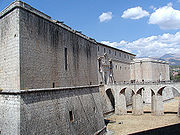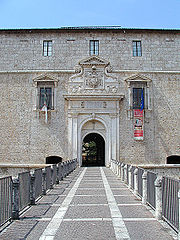
Forte Spagnolo
Encyclopedia

Renaissance
The Renaissance was a cultural movement that spanned roughly the 14th to the 17th century, beginning in Italy in the Late Middle Ages and later spreading to the rest of Europe. The term is also used more loosely to refer to the historical era, but since the changes of the Renaissance were not...
castle in L'Aquila
L'Aquila
L'Aquila is a city and comune in central Italy, both the capital city of the Abruzzo region and of the Province of L'Aquila. , it has a population of 73,150 inhabitants, but has a daily presence in the territory of 100,000 people for study, tertiary activities, jobs and tourism...
, central Italy
Italy
Italy , officially the Italian Republic languages]] under the European Charter for Regional or Minority Languages. In each of these, Italy's official name is as follows:;;;;;;;;), is a unitary parliamentary republic in South-Central Europe. To the north it borders France, Switzerland, Austria and...
.
History
In the 15th century, L'AquilaL'Aquila
L'Aquila is a city and comune in central Italy, both the capital city of the Abruzzo region and of the Province of L'Aquila. , it has a population of 73,150 inhabitants, but has a daily presence in the territory of 100,000 people for study, tertiary activities, jobs and tourism...
had become the second most powerful city in the Kingdom of Naples
Kingdom of Naples
The Kingdom of Naples, comprising the southern part of the Italian peninsula, was the remainder of the old Kingdom of Sicily after secession of the island of Sicily as a result of the Sicilian Vespers rebellion of 1282. Known to contemporaries as the Kingdom of Sicily, it is dubbed Kingdom of...
after Naples
Naples
Naples is a city in Southern Italy, situated on the country's west coast by the Gulf of Naples. Lying between two notable volcanic regions, Mount Vesuvius and the Phlegraean Fields, it is the capital of the region of Campania and of the province of Naples...
itself: there were half a million sheep, wool and saffron were exported throughout Europe; all this unfortunately was lost when the Aquilans, during the war between the French and the Spaniards for the throne of Naples, sided with the French. In 1504 Aquila the city was occupied by the Spanish conquerors. Then in 1527 the French recovered the city with the support of the citizens and the surrounding town. One year later Viceroy Philibert of Orange, ruling for King Charles V
Charles V, Holy Roman Emperor
Charles V was ruler of the Holy Roman Empire from 1519 and, as Charles I, of the Spanish Empire from 1516 until his voluntary retirement and abdication in favor of his younger brother Ferdinand I and his son Philip II in 1556.As...
of Spain
Spain
Spain , officially the Kingdom of Spain languages]] under the European Charter for Regional or Minority Languages. In each of these, Spain's official name is as follows:;;;;;;), is a country and member state of the European Union located in southwestern Europe on the Iberian Peninsula...
, finally defeated the Aquilan rebels and ordered the city to build a fortress in the highest spot North of the city, exactly where in 1401 King Ladislaus had built a garrison to control the unruly and rebellious Aquilans.
The project was entrusted to a Spanish architect, Pedro Luis Escrivà, an expert of firearms, who had begun to build Castel Sant'Elmo in Naples. The discovery of gunpowder obliged to new methods of defensive construction. Escribà was in charge of the project for 2 years, leaving the task to Gian Girolamo Escribà.
In the following 30 years the heavy taxes necessary to build the fortress impoverished the city, which in 1567 begged the Spaniards to stop the construction; the Royal Court granted the request, and works were interrupted, so parts of the castle were never completed. The fortress had cost an enormous sum for the times, and Aquila was obliged also to sell the thick silver case containing the body of St. Bernardine from Siena.
The fortress, which had been built not to defend the city, but to control it (its cannons pointed to the city) and to be a completely self-sufficient structure, was never used in a battle.
Architecture

Escrivà did not forget any detail: the slanted walls would reject enemy fire to the sides; each bastion consisted of two separate and completely self-sufficient environments - called "case matte" - almost independent garrisons on their own. Also the aqueduct to the city was deviated so as to supply the fortress first of all, and in case of rebellion block the water supply.
Moreover, Escrivà planned a special anti-mine corridor, a kind of empty space between the outer and inner walls which could be walked only by one man at a time (and which can be visited today), aiming at defending the castle in case of explosion in case enemy soldiers excavated tunnels to leave mines at the foundations. A whole hill was leveled down to supply the white stone necessary for the fortress, while the city's bells were melted to make the cannons.
In 1798 the citizens fought against the French who had invaded Italy, attacking, in vain, the fortress. From then on, the building was used as a prison. After 1860 it became a military headquarters, and in the Second World War was occupied and damaged by the Germans. Between 1949 and 1951 the castle was restored, and chosen as the seat of the Museo Nazionale d'Abruzzo
Museo Nazionale d'Abruzzo
The Museo Nazionale d'Abruzzo is hosted in the Forte Spagnolo of L'Aquila.The Museum is on three floors: on the ground floor, there is the giant skeleton of an Archidiskon meridionalis found a few miles from Aquila in 1954, and an archeological section with pieces of the Italic pre-Roman period, a...
.

